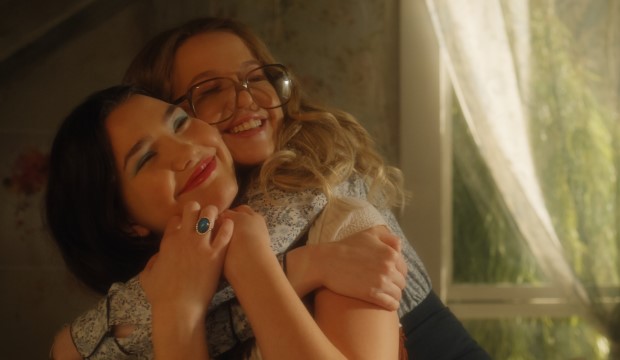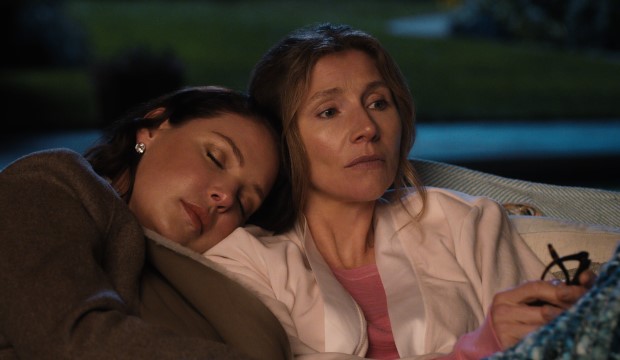Firefly Lane, Netflix review ★★★★★
This new Netflix soap opera follows best friends Tully (Katherine Heigl) and Kate (Sarah Chalke) as they grow from childhood to their 40s, trying to make it as journalists
Katherine Heigl and Sarah Chalke in Firefly Lane, Netflix
Episodes watched: 10 of 10
It’s likely that Netflix’s latest offering of soap and trash will perform well this week, and good luck to it. Because even though Firefly Lane is an annoyingly bombastic show that melts some of your brain away, writer/creator Maggie Friedman (Dawson's Creek) makes you stay with it.
You can unwittingly muster feelings for its functional protagonists and villainous caricatures. You can simultaneously enjoy and despise the best-friendship of the carpe diem extrovert Tully (Katherine Heigl) and the geeky introvert Kate (Sarah Chalke) – indulging their romances, mistakes and traumas. It’s the sort of guilty-pleasure experience that encourages hate-watching.
But the series isn’t hopelessly mindless, carrying an 18-certificate and a fierce feminist drive: plunging into women’s issues that range from the ordinary to the traumatising.

Ali Skovbye (left) and Roan Curtis (right) as the teenage 'Firefly Girls', Tully and Kate. Photo: Netflix
Ten episodes hop between three different time periods. In a glowing 1974, presented like the lens was smeared with Vaseline, the teenage Kate (Roan Curtis) and Tully (Ali Skovbye) meet and become best friends.1984 is filled with bright colours and aerobics gear, and it’s when the 24-year-old 'Firefly Girls' (as they call themselves) pursue their dreams to become journalists – starting at the bottom.
And then comes a mundane 2003, when Tully hosts her own chat-show and Kate has focused on her family. But Kate is going through a rough divorce, and is hoping to jump back into journalism in her 40s.
These stages muddle around, with memories and events connected by theme. It’s a structure that’s more confused and complicated than The Serpent on BBC One, and even goes one time-period further with a mysterious death in 2005.
But the non-linear storytelling is mostly accessible. The decade-relevant changes in the décor and music make that very clear and so do the characters, who consistently enunciate the year they're in. Often the editing is commendably precise, mixing all three periods together into one confluent wave.

Tully (Katherine Heigl) and Kate (Sarah Chalke) in 2003. Photo: Netflix
Tully endures the most trauma, the writers trying their best to knock her down. (Kate’s skewered family life is a relief by comparison.) She always flies back up again, like a divine force who loves the attention. Because Heigl (Knocked Up, Grey’s Anatomy) was famously given a ‘difficult’ reputation because of her outspoken views against industry sexism, this role is a perfect fit.
But Tully's freedom and hedonism often come at the detriment of her friendship with Kate, who sometimes loathes and envies the power she herself can’t conjure up. Chalke is equally ideal casting, possessing as much charming nerdiness as Elliott Reid in Scrubs.
The tonal balances can be dizzying. The trauma occasionally slides against the froth: timelines twisting together, confusing your feelings. An upsetting rape scene in episode two is quickly succeeded by a much lighter scene. It punched this critic out hard, and it took him time to find anything joyful for the rest of the hour. It definitely deserves a heavier trigger warning, as well as a longer recovery period.
There are many ridiculous moments, too, usually involving the tracklist. It plays like a basic compilation of hit songs from the 70s, 80s and noughties. Now That’s What I Call Music comes to mind, as Kate sings Chumbawumba at karaoke or Tully plays croquet to Outkast. And yet, despite the silliness, it’s so easy to be pulled in against your will. Be warned.
Firefly Lane is available on Netflix from Wednesday 3 February
It’s likely that Netflix’s latest offering of soap and trash will perform well this week, and good luck to it. Because even though Firefly Lane is an annoyingly bombastic show that melts some of your brain away, writer/creator Maggie Friedman (Dawson's Creek) makes you stay with it.
You can unwittingly muster feelings for its functional protagonists and villainous caricatures. You can simultaneously enjoy and despise the best-friendship of the carpe diem extrovert Tully (Katherine Heigl) and the geeky introvert Kate (Sarah Chalke) – indulging their romances, mistakes and traumas. It’s the sort of guilty-pleasure experience that encourages hate-watching.
But the series isn’t hopelessly mindless, carrying an 18-certificate and a fierce feminist drive: plunging into women’s issues that range from the ordinary to the traumatising.

Ali Skovbye (left) and Roan Curtis (right) as the teenage 'Firefly Girls', Tully and Kate. Photo: Netflix
Ten episodes hop between three different time periods. In a glowing 1974, presented like the lens was smeared with Vaseline, the teenage Kate (Roan Curtis) and Tully (Ali Skovbye) meet and become best friends.1984 is filled with bright colours and aerobics gear, and it’s when the 24-year-old 'Firefly Girls' (as they call themselves) pursue their dreams to become journalists – starting at the bottom.
And then comes a mundane 2003, when Tully hosts her own chat-show and Kate has focused on her family. But Kate is going through a rough divorce, and is hoping to jump back into journalism in her 40s.
These stages muddle around, with memories and events connected by theme. It’s a structure that’s more confused and complicated than The Serpent on BBC One, and even goes one time-period further with a mysterious death in 2005.
But the non-linear storytelling is mostly accessible. The decade-relevant changes in the décor and music make that very clear and so do the characters, who consistently enunciate the year they're in. Often the editing is commendably precise, mixing all three periods together into one confluent wave.

Tully (Katherine Heigl) and Kate (Sarah Chalke) in 2003. Photo: Netflix
Tully endures the most trauma, the writers trying their best to knock her down. (Kate’s skewered family life is a relief by comparison.) She always flies back up again, like a divine force who loves the attention. Because Heigl (Knocked Up, Grey’s Anatomy) was famously given a ‘difficult’ reputation because of her outspoken views against industry sexism, this role is a perfect fit.
But Tully's freedom and hedonism often come at the detriment of her friendship with Kate, who sometimes loathes and envies the power she herself can’t conjure up. Chalke is equally ideal casting, possessing as much charming nerdiness as Elliott Reid in Scrubs.
The tonal balances can be dizzying. The trauma occasionally slides against the froth: timelines twisting together, confusing your feelings. An upsetting rape scene in episode two is quickly succeeded by a much lighter scene. It punched this critic out hard, and it took him time to find anything joyful for the rest of the hour. It definitely deserves a heavier trigger warning, as well as a longer recovery period.
There are many ridiculous moments, too, usually involving the tracklist. It plays like a basic compilation of hit songs from the 70s, 80s and noughties. Now That’s What I Call Music comes to mind, as Kate sings Chumbawumba at karaoke or Tully plays croquet to Outkast. And yet, despite the silliness, it’s so easy to be pulled in against your will. Be warned.
Firefly Lane is available on Netflix from Wednesday 3 February
TRY CULTURE WHISPER
Receive free tickets & insider tips to unlock the best of London — direct to your inbox
| What | Firefly Lane, Netflix review |
| When |
03 Feb 21 – 03 Feb 22, ON NETFLIX |
| Price | £n/a |
| Website | Click here for more information |